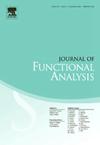关于Hardy-Morrey不等式
IF 1.6
2区 数学
Q1 MATHEMATICS
引用次数: 0
摘要
Morrey的经典不等式暗示了一个函数的Hölder连续性,其梯度是充分可积的。另一个结果是hardy型不等式λ udΩ1−n/p‖∞p≤∫Ω|Du|pdx对于任何开集Ω≠Rn。这个不等式对Ω中支持的函数有效,并且λ是独立于u的正常数。关键的假设是指数p超过维数n。本文旨在为这个不等式和相关的变分问题建立一个基本理论。特别地,我们研究了Ω的几何性质、尖锐常数和饱和不等式的非平凡u的存在性之间的关系。本文章由计算机程序翻译,如有差异,请以英文原文为准。
On a Hardy–Morrey inequality
Morrey's classical inequality implies the Hölder continuity of a function whose gradient is sufficiently integrable. Another consequence is the Hardy-type inequality for any open set . This inequality is valid for functions supported in Ω and with λ a positive constant independent of u. The crucial hypothesis is that the exponent p exceeds the dimension n. This paper aims to develop a basic theory for this inequality and the associated variational problem. In particular, we study the relationship between the geometry of Ω, sharp constants, and the existence of a nontrivial u which saturates the inequality.
求助全文
通过发布文献求助,成功后即可免费获取论文全文。
去求助
来源期刊
CiteScore
3.20
自引率
5.90%
发文量
271
审稿时长
7.5 months
期刊介绍:
The Journal of Functional Analysis presents original research papers in all scientific disciplines in which modern functional analysis plays a basic role. Articles by scientists in a variety of interdisciplinary areas are published.
Research Areas Include:
• Significant applications of functional analysis, including those to other areas of mathematics
• New developments in functional analysis
• Contributions to important problems in and challenges to functional analysis

 求助内容:
求助内容: 应助结果提醒方式:
应助结果提醒方式:


